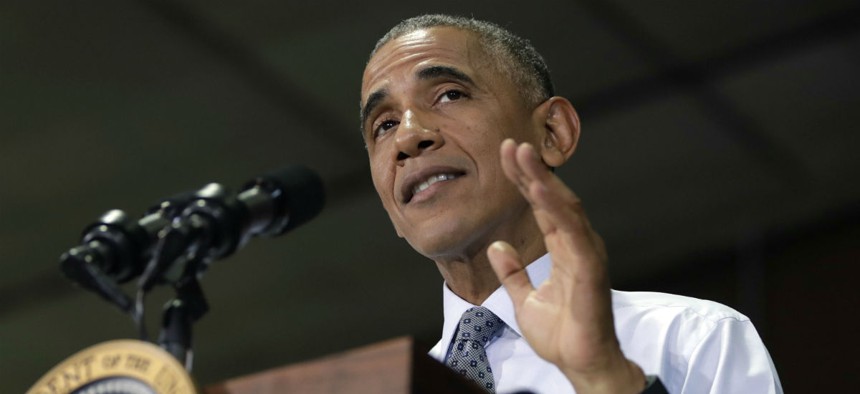
Carolyn Kaster/AP
Obama Orders New Diversity Push in National Security Agencies
Presidential memo adds new reporting requirements and rewards aimed at enhancing problem-solving.
Describing an American society that can trace its “roots to every region around the world,” President Obama on Wednesday issued a presidential memorandum requiring a steadier focus on promoting demographic diversity in the workforce of agencies involved in intelligence, defense, diplomacy and homeland protection.
Effective immediately, national security agency managers must increase demographic reporting on inclusiveness and create new incentives to bring in more women and minorities at senior levels as well as for rank-and-file positions, according to the memo and an accompanying fact sheet.
“As the United States becomes more diverse and the challenges we face more complex, we must continue to invest in policies to recruit, retain, and develop the best and brightest from all segments of our population,” Obama wrote. “Research has shown that diverse groups are more effective at problem-solving than homogeneous groups, and policies that promote diversity and inclusion will enhance our ability to draw from the broadest possible pool of talent, solve our toughest challenges, maximize employee engagement and innovation, and lead by example.”
The memo comes three months after the intelligence community for the first time published numbers on diversity at its 17 agencies. It also follows several decisions by the Defense Department to assure equal advancement opportunities for women and transgender individuals in uniform, as well as a June initiative by the Justice Department to train law enforcement officials and prosecutors to guard against implicit racial bias.
It expands on Obama’s own 2011 executive order instructing all agencies to develop data-driven workforce diversity and inclusiveness plans. “Promoting diversity and inclusion within the national security workforce must be a joint effort,” Obama said in Wednesday’s message, “and requires engagement by senior leadership, managers, and the entire workforce, as well as effective collaboration among those responsible for human resources, equal employment opportunity, and diversity and inclusion issues.”
The new order affects the Defense Department’s civilian and military workforces, the intelligence agencies and the State, Justice, Treasury and Homeland Security departments.
Specifically, the president noted that inclusiveness should be measured not just in broad numbers but at the highest-paying, highest influence positions. For example, he wrote, “as of 2015, only the Department of State and USAID Civil Services were more diverse in terms of gender, race, and ethnicity than the federal workforce as a whole. When comparing the agencies' workforces to their leadership personnel (Senior Executive Service or its equivalent), all agencies' leadership staffs were less diverse than their respective workforces in terms of gender, and all but DoD enlisted personnel and USAID Civil Service had less diverse leadership in terms of race and ethnicity.”
Tools and procedures for implementing the order included expanded data collection, analysis and public dissemination; increasing professional development offerings consistent with merit system principles; conducting “stay and exit interviews” or surveys; new career advancement opportunities while reviewing geographic limitations for applicants; new rewards and accountability steps for supervisors to encourage diversity; and expanded training on “unconscious bias, inclusion and flexible work policies.”
The order demands a progress report within 120 days to be compiled by the assistant to the president for national security affairs in consultation with the directors of the Office of Management and Budget and the Office of Personnel Management. That extends into the next administration.







